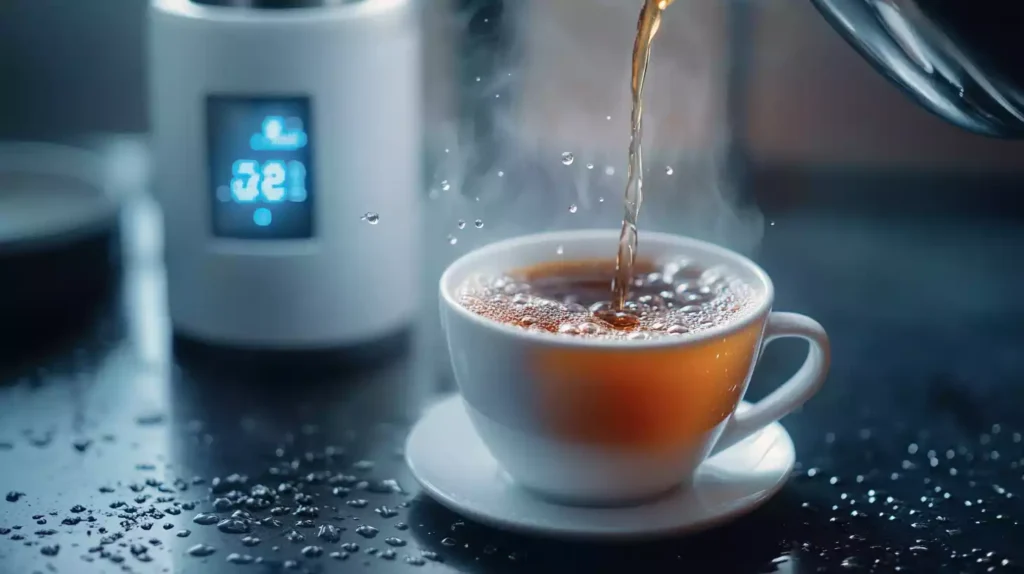I’ve often wondered what makes a cup of coffee truly exceptional. I’ve discovered that it’s not just about the caffeine kick. There’s a complex interplay of factors that contribute to a coffee’s taste, from the origin of the beans to the final brewing method.
Each element plays a vital role in creating that perfect, satisfying sip. But what exactly are these factors, and how do they work together to produce a coffee that’s not just drinkable, but downright delicious? Let’s look at the art and science behind a tasty cup of coffee.
Quick Summary
- Bean origin and variety greatly influence flavor, with each region producing unique taste profiles.
- The roasting process determines depth of flavor, from light and fruity to dark and bold.
- Brewing method affects taste, with French press producing full-bodied coffee and pour-over yielding clean flavors.
- Water quality and temperature are crucial, with filtered water and 195-205°F being optimal for extraction.
- Coffee freshness impacts taste significantly, with beans being at peak flavor within two weeks of roasting.
Bean Origin and Variety
Where do your favorite coffee beans come from? If you’re like me, you might not have given it much thought. But trust me, it matters!
The origin of coffee beans plays a huge role in determining their taste. Coffee beans, whether regular or espresso, can be processed in natural or washed methods and roasted to multiple degrees of darkness, which also affects the flavor.
Coffee grows in what’s called the “Bean Belt,” a region around the equator. Each country in this belt produces beans with unique flavor profiles. For instance, Colombian beans often have a nutty, chocolatey taste, while Ethiopian beans can be fruity and floral.
But it’s not just about the country. The specific variety of coffee plant matters too. Arabica and Robusta are the two main types, with Arabica being the darling of coffee connoisseurs. It’s generally sweeter and more complex than its robust cousin.
Even within these categories, there are countless subspecies and hybrids. Each one brings its own special something to your cup.
Roasting Process and Profile
Every coffee bean undergoes a pivotal transformation through roasting, which vitally impacts its final flavor. I’ve learned that roasting is both an art and a science, where time and temperature play a delicate dance.
As the beans heat up, they change color, size, and chemistry, developing those rich flavors we crave in our morning cup. Washing green coffee beans before roasting can affect the final taste of the coffee.
The freshness of the beans is key to ensuring a good cup of coffee, and green coffee beans have a shelf life of around six months, depending on storage conditions.
The roast profile determines whether you’ll end up with a light, medium, or dark roast. Each level brings out different characteristics in the bean. I’ve found that lighter roasts tend to highlight the bean’s unique origin flavors, while darker roasts emphasize bold, caramelized notes.

Beans undergo significant changes during roasting:
- Beans lose moisture and expand
- Sugars caramelize, creating complex flavors
- Oils rise to the surface (especially in dark roasts)
- Acids break down, affecting acidity and body
- Aromatic compounds develop, enhancing the coffee’s bouquet
As you try out different roasts, you’ll discover your personal preference. Maybe you’ll love the bright acidity of a light roast, or perhaps you’ll favor the smoky richness of a dark roast.
The beauty of coffee is in its diversity – there’s a roast for every palate!
Brewing Methods and Equipment
For a full-bodied cup, I swear by the French press. It’s like giving your coffee a warm hug, letting all those oils and flavors mingle.
If you’re after precision, the pour-over method might be your new best friend. It’s a bit fussy, but the clean, bright flavors are worth the effort. Did you know that investing in a coffee grinder can control the grind size for freshness?
Experimenting with different grind sizes can make a huge difference in the flavor of your coffee.
A good machine can turn you into a home barista faster than you can say “cappuccino.” And don’t forget about the humble drip coffee maker – it’s reliable and perfect for those bleary-eyed mornings.
Whatever method you choose, remember that fresh, clean water and the right grind size are really important for a tasty coffee.
Try different techniques and find what tickles your taste buds. After all, the best brew is the one that makes you smile with that first sip.
Water Quality and Temperature
When it comes to brewing the perfect cup of coffee, water quality and temperature play crucial roles that many overlook. I’ve learned through trial and error that using filtered water can make a world of difference in taste. It’s like giving your coffee beans a clean canvas to paint their flavors on.
Now, let’s talk temperature. You don’t want to scald your grounds with boiling water, but you also don’t want lukewarm coffee. I aim for water between 195°F and 205°F – it’s the sweet spot for extracting those delicious flavors without bitterness.

These are my personal tips for tasty coffee using quality water and the best temperature:
- Use filtered water for a cleaner taste
- Aim for water temperature between 195°F and 205°F
- Avoid reheating coffee – it’ll taste bitter
- Invest in a good kettle with temperature control
- Preheat your cup to maintain ideal temperature
I’ve found that paying attention to these details can transform your morning brew from “meh” to “marvelous”!
Storage and Freshness
Now that we’ve nailed the water situation, let’s turn our attention to keeping those coffee beans in tip-top shape.
Storage and freshness are vital for maintaining that delicious flavor we all crave. You don’t want to be sipping on stale coffee – it’s like drinking sadness in a cup!
First things first: light, heat, air, and moisture are your coffee’s worst enemies.
I’d recommend storing your beans in an airtight container, away from direct sunlight and heat sources. A cool, dark pantry is perfect. And please, don’t stick them in the fridge or freezer – they’ll absorb unwanted odors and moisture.
Now, let’s talk freshness.
Coffee beans are at their peak within two weeks of roasting. After that, they start losing their oomph. I suggest buying smaller quantities more frequently, rather than hoarding a year’s supply.
Whole beans stay fresher longer than ground coffee, so invest in a good grinder if you can. Grind just before brewing for maximum flavor.
Remember, fresh beans equal tasty coffee, and tasty coffee equals happy you!
Alex is a self confessed coffee addict – but he takes his love of caffeine seriously in a completely responsible way. He loves trying new coffees and testing the latest machines and is not usually fan of one button pod machines. Alex is happiest when he is tinkering with settings and milk temperatures to create the perfect cup. When not obsessing over coffee, Alex is a keen musician and plays weddings and other social events (usually fuelled by… yes, you guessed it… coffee).


